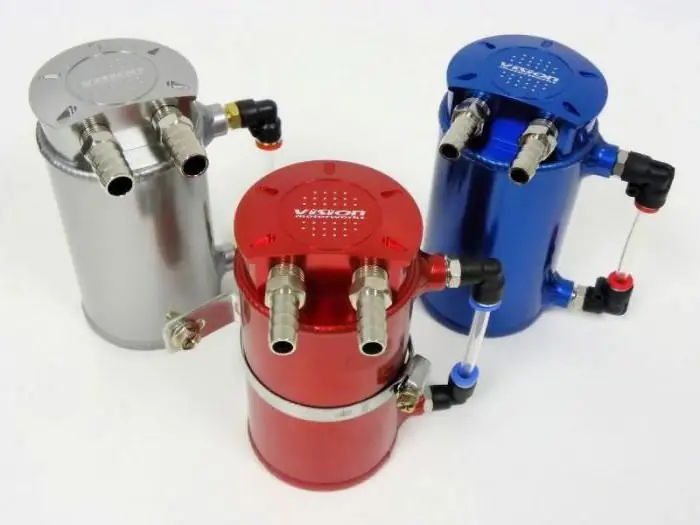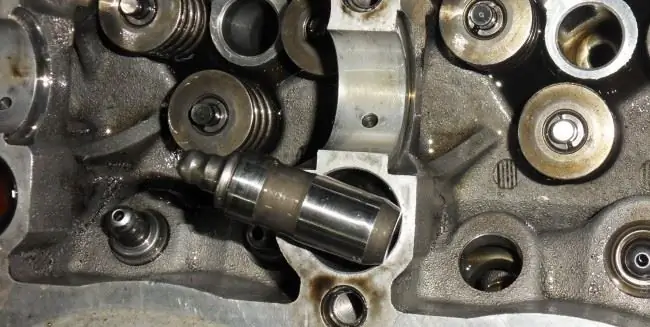2025 Author: Erin Ralphs | [email protected]. Last modified: 2025-01-22 21:14:11
The gas distribution mechanism is an integral part of any internal combustion engine. The timing system includes several elements, including valves. These parts contribute to the intake of a combustible mixture and the subsequent release of gases from the combustion chamber. On a serviceable motor, the valves should not make any sounds. But what to do if there is a knock of valves? The reasons for this phenomenon and troubleshooting methods are further in our article.
Summary of characteristics and principle of operation
Valves in the internal combustion engine are used to supply a mixture of fuel and air, as well as to release exhaust gases. The valve consists of a stem and a plate. There are elements in the cylinder head. There can be two valves in total (sometimes four). Inlet and outlet. For better filling of the cylinders, the diameter of the first one is always larger. The valve opens thanks to the camshaft cams.

The latter rotates from the crankshaft via a chain or belt. Also, on modern internal combustion engines, hydraulic compensators are used, which implement the optimal thermal clearance of the valves in all positions. This ensures smooth operation and less noise.
Why there is a knock
The main reason is the increased clearance between the lever and the camshaft cam. In this situation, the cam will knock on the rocker. At idle, a characteristic metallic clatter will be heard. The larger this gap, the stronger the sound and the more the timing elements wear out.
Insufficient clearance also harms the engine. In this case, the valves are "clamped" and may not close completely. After a while, such an engine may overheat, while compression and power are reduced. Another cause of engine valve knocking is detonation. This is a kind of micro-explosion, in which a fiery wave hits the walls of the cylinders. As a result, valve knocking may occur. Among the signs of detonation, it is also worth noting a decrease in the power of the internal combustion engine, overheating, black smoke from the exhaust pipe, increased vibrations of the power unit.
Why do hydraulic lifters fail?
This can happen for several reasons:
- Natural wear and tear. Typically, such elements become unusable at a run of 200 thousand kilometers.
- Use of poor quality oil or oil of the wrong viscosity. Such a product must meet all standards. Otherwise, valve knocking may occur, since the hydraulic compensatorwon't do the job.
- Clogged plunger head or oil passages. This happens when the oil filter is not replaced on time. As a result, the pressure decreases, the lubricant does not enter the system, sometimes the plunger jams in the housing and the hydraulic compensator stops working completely. This problem can be solved by flushing the hydraulic lifter.

If it's hot
If there is a knock of valves on the hot, what could be the reason? Most often this happens due to low oil pressure at high speeds. This can happen to both the inlet and outlet element.
Valve knocking when cold
In this situation, the reason is the wear of the pusher. It can get dirty, it could leak. As a result, there is an incomplete supply of oil to the valves. If the oil pressure is in order, you need to check the gaps. This can be done using special probes. The reader can see such a tool in the photo in the article.

One of the probes is installed between the cam and the pusher (or between the rocker arm and the rod, depending on the location of the camshaft) and the gap is measured. For each car, this parameter is individual.
Engine knocked on the road
If the engine suddenly starts to make a clatter while driving, the first thing to check is the oil level. If it is insufficient, even with a working pump, normal lubrication of all elements will not be ensured. The level should alwaysbe no lower than the middle.

Need to find out if valve knock gets worse under load and as speed increases. If so, the crankshaft bearings in the engine are most likely worn out. Another knock may occur immediately after refueling. This indicates poor quality fuel. Usually such knocks are fading in nature, they are not fatal to the engine. But in the future it is better to change the gas station. How to fix valve knock? Depending on the design of the timing mechanism, each cylinder in the engine may have two or four valves. Some launch the combustible mixture, others remove gases. Since the elements operate at high temperatures, they can expand. Therefore, the gap will change. If the valves are adjusted incorrectly, this leads to rapid wear of the timing elements and to a loss in the performance of the internal combustion engine as a whole. With an increased gap, the valves will not fully open. If not enough, they will burn along with the saddles.
If there are no hydraulic compensators in the internal combustion engine, experts recommend adjusting the valve clearances every 25 thousand kilometers. Also, for correct operation, such elements should be cleaned. During operation, the valves are overgrown with soot. It prevents them from working in normal positions. If the gap is optimal, and the valves are clean, the car will work stably and not waste fuel.

How to adjust the thermal gap?
Let's consider how to eliminate valve knock on a VAZ car. This will requirea standard set of heads and open-end wrenches, as well as a probe with a thickness of 0.15 millimeters. The work on adjusting the gaps is performed in the following sequence:
- Shift into neutral and set the stop under the rear wheel.
- Waiting for the motor to cool down to 20 degrees.
- Using a 10 wrench, unscrew all the valve cover bolts.
- Install the crankshaft pulley according to the marks. The camshaft mark will be opposite the arrow on the valve cover.
- Set the gap on the sixth and eighth valves with a feeler gauge. Reading is done from the radiator.
- The crankshaft is rotated half a turn.
- Perform adjustment of the fourth and seventh valves.
- The crankshaft is rotated half a turn again. Adjust the clearance of the first and third valves. After that, the second and fifth valves are adjusted.

At the end of the procedure, you need to double-check all the gaps. Also note that when the lock nuts are tightened, the gap will decrease. The valve must not be allowed to be stuck. The probe should move with slight friction, without effort.
Conclusion
So we figured out why valve knocking happens. There may be several reasons for this phenomenon. But basically, valve knock appears due to incorrect clearance. If the motor is equipped with hydraulic lifters, it is likely that they are clogged and out of order. There is no need to adjust the valves on such motors - just replace the worn-out hydraulic compensator.
Recommended:
The principle of operation of the variator. Variator: device and principle of operation

The beginning of the creation of variable programs was laid in the last century. Even then, a Dutch engineer mounted it on a vehicle. After such mechanisms were used on industrial machines
Where is the PCV valve located? Characteristics and principle of operation

PCV - forced crankcase ventilation system. The functioning of the power unit of the car largely depends on its condition. The main task of this system is the removal of crankcase gases from the engine. They are available in all power units, regardless of their novelty and service life. The only difference between them is the composition and quantity
Knock sensor. Principle of operation and verification

Modern cars are equipped with various sensors, based on the readings of which the control unit regulates the operation of the entire unit. One of these elements involved in the fuel injection system is the knock sensor, the principle of operation of which is based on the piezoelectric effect
Knock when braking: possible causes, troubleshooting and recommendations

On numerous thematic forums, motorists complain that from time to time they hear uncharacteristic sounds and vibrations when braking. This knock occurs in various situations. We will analyze the causes of this unpleasant phenomenon, and also learn how to troubleshoot
"Brains" VAZ-2114: types, principle of operation and diagnostics

VAZ-2114 is equipped with a modern injection engine. The operation of the power unit is fully controlled by the ECU (electronic engine control unit or "brains" of the machine). Consider how the “brains” of the VAZ-2114 work, what types they are, where the computer is located, what malfunctions the owner may encounter, how to diagnose this device

